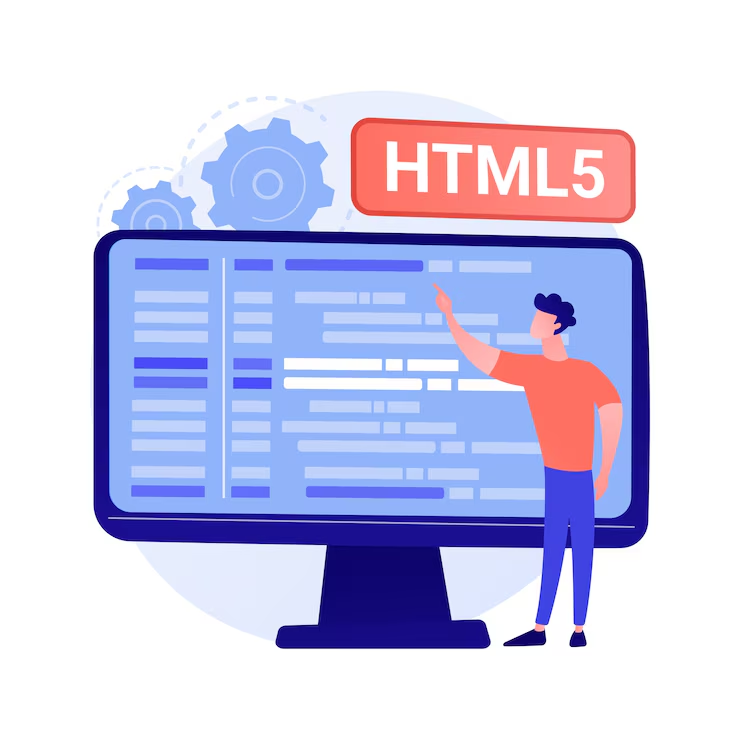Top 10 HTML5 Tags Every Developer Must Know
Top 10 HTML5 Tags Every Developer Must Know

HTML5 introduced a range of powerful tags that enhance structure, accessibility, and SEO. This blog covers the top 10 essential HTML5 tags like <header>, <section>, <article>, and more. Each tag is explained with examples to help developers build cleaner, more semantic web pages. Perfect for Happy Coders interns and beginners to master the basics of frontend development. Knowing these tags lays a strong foundation for any modern web project.
1. HTML5 Semantic Tags That Improve Your Website’s Structure
HTML5 introduced semantic tags like <header>, <section>, and <article> to give content more meaning. These tags make your code cleaner and easier for search engines to understand. They improve SEO, accessibility, and site organization. Happy Coders recommends using semantic tags for all modern projects. Structure is key to maintainable code. Write HTML that communicates clearly.
2. The Power of <section> and <article> in Modern HTML
The <section> tag groups related content, while <article> defines self-contained items like blog posts or news. These tags help browsers and developers understand the layout better. Happy Coders uses them to create clean, modular content blocks. Search engines prefer this structured format too. They aren’t just visual—they’re functional. Structure your content the right way.
3. Why Every Developer Should Use the <nav> Tag
Navigation is critical for usability and accessibility. The <nav> tag identifies a set of navigation links, separating them from other content. This helps screen readers and crawlers interpret your layout more accurately. Happy Coders teaches proper <nav> usage in all web projects. It’s simple, semantic, and SEO-friendly. Guide your users with clarity and structure.
4. Creating Better Layouts with <header> and <footer>
HTML5 gives you cleaner layouts with <header> and <footer> tags. They define the top and bottom sections of pages or content blocks. Happy Coders builds reusable components using these tags. They improve readability and semantic flow. Every professional web page should include them. Build pages that are structured, clean, and developer-friendly.
5. HTML5 <figure> and <figcaption> for Smarter Images
Images need context, and <figure> with <figcaption> provide it. Use these tags to group images and their captions semantically. Happy Coders recommends them for galleries, blogs, and tutorials. They improve accessibility and add meaning to visuals. Well-described content ranks and reads better. Enhance your visuals with the right tags.
6. Making Content Editable with the HTML5 contenteditable Attribute
Want in-browser editing? The contenteditable attribute lets users edit text directly on your web page. It’s great for building CMS interfaces, notes, or live previews. Happy Coders uses it in training projects and admin panels. It brings interactivity without JavaScript. Quick, useful, and surprisingly powerful. Let your content adapt in real-time.
7. HTML5 Video & Audio Tags: Embedding Media Made Easy
With <video> and <audio>, HTML5 lets you embed media without plugins. These tags support multiple file formats and controls. Happy Coders uses them to build multimedia websites and e-learning platforms. They’re mobile-friendly and SEO-compatible. Engage users with sound and motion. Multimedia integration is now simpler than ever.
8. Use <main> to Highlight Your Page’s Core Content
The <main> tag defines the central content of a page. It tells browsers what the main topic is, ignoring headers, sidebars, and footers. Happy Coders uses <main> to enhance accessibility and SEO. It’s especially useful in single-page layouts. Use it once per page for clarity. Help both users and bots focus on what matters.
9. Enhance Forms with HTML5 Input Types
HTML5 introduced input types like email, date, range, and number. These make forms smarter and reduce validation effort. Happy Coders integrates these inputs in modern web forms for better UX. They work seamlessly with mobile devices too. Let the browser help with form handling. Simpler code, smarter behavior.
10. The <details> and <summary> Tags for Collapsible Content
Want to hide and show extra info without JavaScript? Use <details> and <summary>. These tags create collapsible content sections natively. Happy Coders uses them in FAQs, documentation, and dashboards. Clean, semantic, and interactive—right out of the box. Save space and enhance usability with just two tags.
11. HTML5 Accessibility Tags You Shouldn’t Ignore
Accessibility matters more than ever. Tags like <label>, <fieldset>, and <legend> make forms user-friendly for all. Happy Coders emphasizes accessibility in every project. Good HTML is inclusive HTML. Use semantic tags that work for screen readers and assistive tools. Build websites for everyone, not just some.
12. HTML5 <time> Tag: For Events, Dates, and Timelines
The <time> tag allows you to mark up dates and times clearly. This improves search engine parsing and can power calendar-based features. Happy Coders uses it in blogs, events, and release notes. It helps users understand content timelines visually and programmatically. Clean, human-readable time format—made simple.
13. <mark> Your Words: Highlighting Text the Smart Way
Want to draw attention to keywords or search matches? The <mark> tag highlights text without using CSS. It’s great for search results, summaries, or alerts. Happy Coders includes it in interactive UIs and blog search features. Emphasize content while keeping code semantic. Make important info stand out the right way.
14. HTML5 Forms: Simplified with Built-In Validation
No more full JavaScript setups for basic validation. HTML5 provides attributes like required, pattern, and maxlength. Happy Coders teaches how to use these to build smarter forms quickly. Browsers handle errors automatically. It saves time, code, and improves UX. Let HTML5 do the heavy lifting.
15. Writing Clean Code with HTML5: Developer’s Best Practices
HTML5 is not just about tags—it’s about clean, semantic, maintainable code. Happy Coders encourages developers to use best practices like proper indentation, tag hierarchy, and structure. Clean code makes debugging and collaboration easier. Use HTML5’s full power, not just its basics. Write code that speaks for itself.



